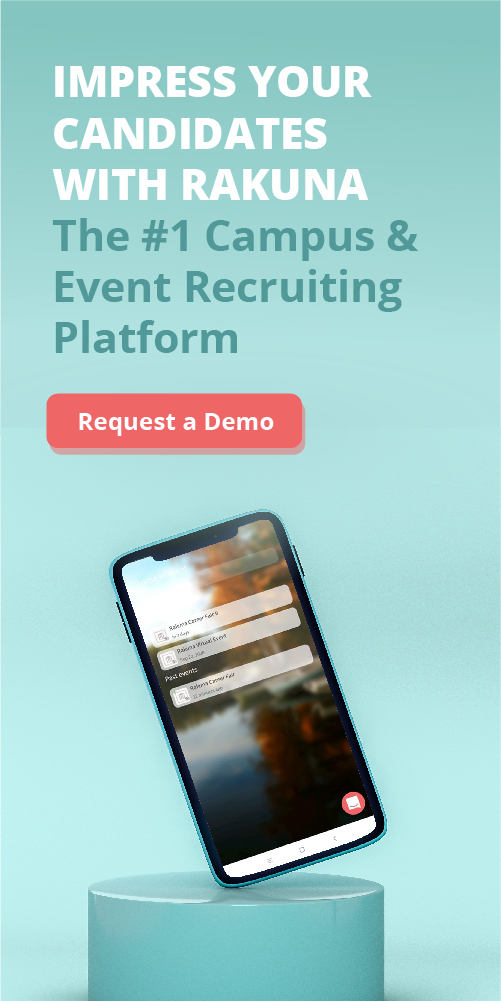COVID-19 has made remote teams and virtual recruiting become the new normal. Despite hurting the job market and presenting an unprecedented challenge for recruiters, the pandemic also speeds up the digital transformation in many functions, recruiting included and encouraging modern recruiters to develop new strategies to find talents.
Desperate time calls for adaptive measures; those who thrive will lead the game when normalcy is restored. For example, Charter was able to hire 3000 new employees 100% virtually during the last few months, and they will possibly be in a good position when the offices resume openings. Interested in how to adopt a wide range of virtual recruiting tactics? Here is Rakuna’s guide to virtual recruiting with best practices.
Virtual Recruiting in a Nutshell
Virtual Recruitment has been around for years, and many of us have probably implemented at least one or two methods. However, the need for virtual talent acquisition has rocketed since the COVID-19 outbreak, and now virtual recruiting is required everywhere.
What is Virtual Recruiting?
Virtual recruitment employs a wide range of virtual HR tools, tactics, and resources to find, influence, interview, qualify, and onboard the best candidates. This way of recruiting can be integrated into organizations’ recruitment plans under different circumstances to maximize the quality of hires. Virtual recruiting becomes especially effective when you have to deal with a large number of applicants, remote hiring needs, and unprecedented challenges, e.g., COVID-19. This agile recruitment strategy has been implemented in many organizations and businesses, including both multinational corporations, SMEs, and start-ups.
Advantages of Implementing Virtual Recruiting
The top benefits of using virtual recruiting tactics in your recruitment plan involve:- Eliminating in-person interactions and sustaining an engaged workforce to maintain business performance during the pandemic
- Alleviating administrative burdens and cutting down on unnecessary paperwork
- Reducing costs either in terms of monetary, time, or team efforts. Transcending geographical barriers
Check out this Virtual Career Fair Guide for a detailed analysis of the advantages of implementing virtual recruiting.
Common Types of Virtual Recruiting Methods
The top five standard methods of virtual recruiting include:
- Virtual Career Fairs, the growing trend in online recruitment
- Virtual Assessments, ranging from basic online tests to complex gamified challenges and online assessment center
- Virtual Interview, which includes both one-way and two-way interviews
- Virtual Onboarding, which helps new hires adapt to the job effectively. Online job boards, social media, email campaigns, etc.

Virtual Career Fairs Highlights
Virtual career fairs are job events organized via online platforms that help businesses connect with job-seekers. Organizations can choose to build their online sites or have a booth at the top virtual recruiting events. They are probably identical to the traditional job fairs, yet with a few technical perks, such as:
- The ability to have customized branding elements for owned sites,
- Providing interactive content (You can give presentations, post videos, share documents, or send out necessary links for on-the-spot engagement with candidates.)
- Having detailed information on attendees and records of their behaviors for after-event performance evaluation and follow-up.
Virtual Assessment & Exciting Best Practices
So, What is Virtual Assessment?
Virtual assessment is the second stage of recruitment, usually referred to as a pre-employment or a pre-interview assessment organized via online channels to help employers evaluate the qualifications of their prospective employees effectively and conveniently. While the most common forms of virtual assessment are online one-way tests for sorting candidates, some organizations are also moving their assessment centers to online spaces in response to changes in environmental factors.
In terms of design and implementation, this method ranges from measuring candidates’ competency levels with hard skills, numerical, logic, and verbal tests to evaluating cultural fit with behavior and personality tests. Additionally, according to SHRM, 82 percent of companies use some form of pre-employment assessment, and the way they use it is evolving.
Some Perks of Using Virtual & Automated Assessment Include:
- Increasing productivity: Automation helps you screen dozens (or even hundreds and thousands) of applicants in a short time and shortlist the brightest candidates based on their scores and recruiting criteria effectively.
- Reducing time-to-hire: As the back-and-forth communication is eliminated and the evaluation of candidates’ qualifications is updated automatically, modern recruiters can shorten the recruiting process between phases.
- Decreasing the harmful effects of personal bias while hiring, and as a result, improving the level of diversity within your organization.

How to Organize Effective Online Assessment?
If you are considering implementing virtual assessment or finding a way to upgrade your online tools in the following months, here are some tips and best practices:
1. Choosing the Right Tools
So, how do you use a wide range of virtual assessments to serve your purpose effectively? Here is our simplified breakdown of the three standard tools:
Using an Automated One-Way Online Assessment as a Quick Screen Tool for Hard Skills
This is probably the most common assessment tool among companies, and it is also especially helpful for large corporations that receive thousands of application forms per recruiting wave. The tests include logic reasoning and numerical and verbal reasoning.
Assessing Candidates’ Capacity with Job Stimulations or Programming Challenges
Recruiters can create a virtual workspace that immerses applicants in critical roles of the organization based on their interest in the application forms to solve real business problems. This type of test involves case-solving, situational judgment, or role-playing challenges. If you are looking for technological talent, consider utilizing well-designed platforms to organize programming challenges for proper assessment. Some of the commonly used platforms for this particular type of evaluation used by top companies such as c, Adobe,… are HackerRank and HackerEarth.
Getting the Whole-Person Impression with Personalities & Culture Fit Tests
To ensure a sustainable employment pipeline, we, as recruiters, are always searching for candidates who “fit”. Those are the ones who not only have the necessary skills and knowledge to perform but also demonstrate desired personality traits, cultural fit, and motivational drivers. Finding the “right” candidate is especially important to drive the growth of an organization, and that’s why conducting this type of test is necessary to look for people in leadership positions.
2. Spicing Up the Experience with Gamified Testing to Replace Traditional Psychometric Tests.
Along with the rise of virtual recruiting, how companies use online assessment is also evolving. Along with the traditional psychometric tests mentioned above, big corporations are stepping up in the recruiting field with gamified assessments. This method, which is powered by advanced technology, requires applicants to solve dynamic problems. Therefore, it improves candidates’ experience and enables companies to track behavioral data and how prospective employees respond to dynamic situations.
An example of this method is PwC’s game-based test called Career Unlocked. According to WikiJob, this engaging way of assessment consists of eleven different games that cover the different skills PwC wants to assess. PwC will then collect and evaluate the data extracted from 3000 data points, which reflect not only gamers’ competencies but also candidates’ thinking processes and approaches to logical problems under pressure.
3. Organizing Online Assessment Center for Real-Time Assessment
The on-ground assessment center has been in the recruitment process of many companies for a long time. However, due to the restrictions of in-person interactions during the current global pandemic situation, modern recruiters are finding adaptive ways to maintain and organize this crucial assessment via online platforms. So, recruiters, no matter how you arrange it based on your company’s resources and situations, here are two notes for you: Keeping it short, personable, and sweet to engage talents. Aiming to have two or three activities with built-in breaks to ensure the energy levels of candidates during the process.
4. Maintaining Recruiting Standards among Alternatives
Having prompt responses addressing candidates’ needs and concerns during the process is crucial to creating positive talent experiences during this strange time. Thus, organizations should appoint and announce a facilitator hotline dedicated to overseeing the process and becoming the contact point in case of emergencies. Companies with many applicants can also consider having an online support system to speed up the process, such as P&G’s virtual job assistant named Olivia. No matter which type of online assessment your company implements, we suggest maintaining best practice assessing standards among alternatives to ensure quality hires.
Virtual Interview: Tips & Best Practices
What will you do when interviewing remote candidates or your hiring manager is unavailable for in-person interactions? The standard approach is organizing Skype/ Zoom/ Hangout meetings. However, there are two primary methods of conducting digital interviews for your consideration:
- One-way Interview: Candidates record their answers based on employers’ questions via email and upload it to video-sharing sites or use online platforms such as HireVue to receive and respond to recruiters’ initial questions.
- Two-way Interview: Candidates connect with hiring managers and interviewers via Zoom, Skype, Hangouts, etc.
While the simple two-way interview via online tools mentioned above seems widely used among businesses, some corporations also adopt advanced technology with up-to-date algorithms to get in-depth information on applicants’ behaviors.
How to Conduct a Seamless Virtual Job Interview?
Communicating the Progress Clearly to both Interviewers & Interviewees
Online interviews may be harder to track, manage, and coordinate than in-person interviews. Therefore, if you plan to organize multiple two-way interviews, ensure that both interviewers and interviewees understand the progress and have proper expectations toward recruiting milestones. You can also utilize modern interview scheduling software to ease the burden of administrative tasks and back-and-forth communications between stakeholders.
Using Pre-Recorded Video Interviews Equipped with Advanced Tools
Though using pre-recorded video interviews may remove the personal touch points between interviewers and candidates, this method is undeniably valuable for the initial stage when you probably have dozens (or even hundreds) of applicants. It also enables candidates to conduct an interview automatically at their convenience. Furthermore, the emergence of new technologies has allowed leading HR vendors to introduce new advanced tools, such as AI-powered screening features. AI applications in video interviews may remove the unconscious bias caused by human errors, analyze candidate behaviors in a timely manner, and provide necessary data to hiring managers.
Unilever is a well-known example of an organization that digitizes its hiring process to achieve high productivity. The leading FMCG corporation has been working with a provider to implement AI-powered interviewing tools, which can record candidates’ responses and analyze interviewees’ behaviors, such as keywords, intonation, and body language. Based on the analysis of collected data points, hiring managers can have an overview of candidates’ personality traits and come up with an objective evaluation.
Staying Mindful of Legal Requirements
While the notes on abiding requirements can be applied to both traditional and virtual interviews, the latter poses a higher risk of legal issues as they leave a digital footprint. Therefore, whether your companies organize two-way interviews or utilize an online “pre-screen” computer program, your interview questions must not violate guidelines or pose a threat of discrimination on a candidate’s protected characteristics. These characteristics include sex, religion, race, age, etc.
Choosing The Convenient Tools for both Candidates and Interviewers
We know that different companies may use different platforms (Skype, Hangouts, Microsoft Teams, etc.) to communicate externally, but your candidates may not possess the proper applications or settings; thus, organizations should avoid using technology that requires users to download anything onto their phone or computer to reduce the risk of technical issues.
Before each virtual interview, recruiters should also give a test run to minimize technical hiccups and maximize candidate experience. A final tip for video interviews and virtual recruiting: A compelling company culture pitch can grab candidates’ attention and differentiate you from employers.

Virtual Onboarding: Best Practices for Your Next Wave of New Hires
Okay, this is probably the end of your virtual recruiting journey. Ideally, we should organize small and in-person onboarding events in the office, where your new employees can get around and meet their future teammates.
However, virtual onboarding happens when A. you have remote employees or B. you need an adaptive measure during an unprecedented time, such as COVID-19, when social distancing is recommended. Though it may seem strange to organize virtual onboarding, no matter the situation, modern recruiters should always maintain the working standards and ensure that your new hires have all the necessary materials to perform and feel like a part of the team.
Now, How to Nail Virtual Onboarding?
Planning and Getting Organized
Make sure that you collaborate with the supervisor and prepare a solid plan of what your new hires will do from day one. It’s always easy to feel lost during the first few days, and without proper preparation, your new employees may stare at their screens or be drowned in a load of information. Here is a quick checklist:
- Sending a welcome email from HR or supervisor
- Providing HR-related materials, including working policies, paperwork, requirements,…
- Setting up necessary tools, working platforms, and accounts
- Mapping a clear plan with tasks and responsibilities
- Introducing to teammates (Tips: You can also connect them to designed buddies, who will be able to support them during the onboarding time and introduce them to the working environment.)
Utilizing Virtual Learning and Communicating Tools
If the onboarding time happens at the office, the new hires can easily reach out to their supervisors or teammates to sort things out. However, challenging times require adaptive measures, and this is an opportunity for the rise of online learning hubs. Utilizing these tools ensures that your new employees have the proper training to perform productively despite the lack of in-person communications and guidance.
We also suggest team managers conduct regular meetings or check-ins with new hires and team members to ensure that the team is on the same page and communicating effectively. These interactions are also opportunities to instill the company culture and values.
Making the Experience Interactive
Okay, so what if you have done all the suggestions above? What can be the next big and exciting thing in virtual recruiting (and virtual onboarding)? At this time, we will bet on virtual reality, which can make candidates’ experiences more interactive and exciting. Recruiters can design simulated office tours to show the natural working environment or the experience of specific roles to give new employees an insight into what they can expect from the job. A fully immersive experience allows them to see and feel the office culture and imagine themselves in a specific role while maintaining social distancing.
Conclusion
Even though more than 82 percent of companies are adopting virtual recruiting methods into their recruitment processes, we believe that moving from partly remote hiring to 100% remote hiring is still a challenge for many companies during this strange time. However, businesses must go on. The surge of virtual recruiting reflects the adaptive strategies of modern recruiters in response to this unprecedented change, and those who manage to adapt will thrive.


